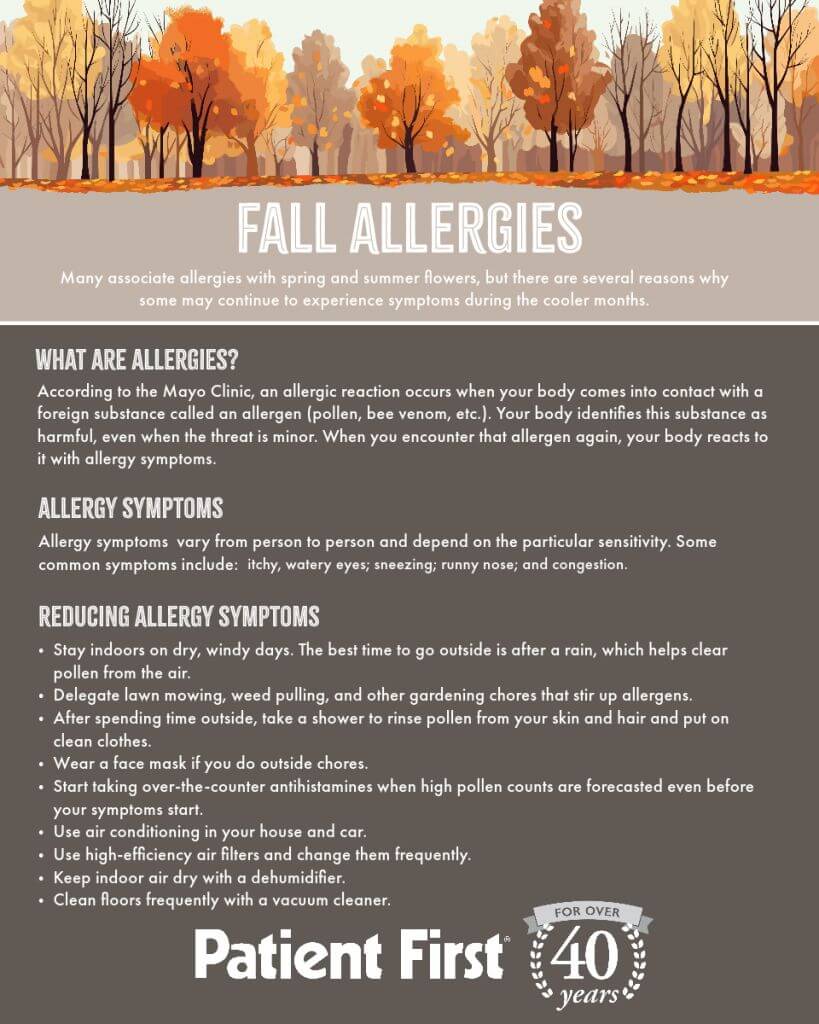Fighting Fall Allergies
Summer is gone with the wind. The heated dog days are being replaced by a crisp, cool breeze, but autumn brings little relief for many allergy sufferers. Ragweed pollen is one of many environmental triggers that trouble millions of allergy sufferers. Others include mold from damp leaves, wet basements, and dust mites. Don’t confuse allergic reactions with cold symptoms.
What Are Allergies?
According to the Mayo Clinic, an allergic reaction occurs when your body comes into contact with a foreign substance- an allergen (bee venom, pollen, etc.). Your body identifies this substance as harmful, even when the threat is minor. When you encounter that allergen again, your body reacts to it with allergy symptoms.
Recognize The Symptoms
Allergy symptoms vary from person to person, depending on their particular sensitivity. Some
common symptoms include:
Itchy, watery eyes
Sneezing
Runny Nose
Congestion
Know The Difference
While suffering from these symptoms may seem like a common cold to you, allergy and cold symptoms differ in two respects.
Colds generally include a fever; allergies do not.
Colds typically last 7-10 days; allergy symptoms may be present for an entire season.
Reducing Allergy Symptoms
Here are 9 steps you can take to reduce allergy symptoms
1. Stay indoors on dry, windy days. The best time to be outdoors is after rain, which clears
the air of pollen.
2. Delegate lawn mowing, weed pulling and other gardening chores that stir up allergens.
3. After spending time outside, take a shower to rinse pollen from your skin and hair, and
put on clean clothes.
4. Wear a face mask if you do outside chores.
5. Take over-the-counter antihistamines when high pollen counts are forecast, even before
your symptoms start.
6. Use air conditioning in your house and car.
7. Use high-efficiency air filters, and change them frequently.
8. Keep indoor air dry with a dehumidifier.
9. Clean floors frequently with a vacuum cleaner.
Treatment
If your seasonal allergies are usually mild, nasal sprays and oral antihistamines can help manage the symptoms. Your body, however, may eventually build up a tolerance to an over-the-counter (OTC) medication. If OTC treatments don’t reduce your symptoms, it may be time to talk to a physician. You may need a prescription or other treatment.
Patient First doctors are available to talk about fall allergies, and ways to avoid them. Contact
Victoria Soriano at (571) 340-1594 or Victoria.Soriano@patientfirst.com to set up an in-person interview, or via Zoom.
###
About Patient First
All Patient First Medical Centers are open 8 a.m. to 8 p.m. every day of the year, including holidays.
Patient First provides non-appointment urgent care for routine injuries and illnesses, as well as
primary care for patients who do not have a regular physician. Each Patient First center has on-site digital x-ray, on-site laboratory, and on-site prescription drugs. Patient First currently operates medical centers in Virginia, Maryland, Pennsylvania, and New Jersey.
Media Contact: Victoria Soriano
(703) 652-1572 (Office)
(571) 340-1594 (Mobile)
Victoria.Soriano@patientfirst.com
www.facebook.com/PatientFirst
twitter.com/PatientFirst
https://www.instagram.com/patientfirst/

